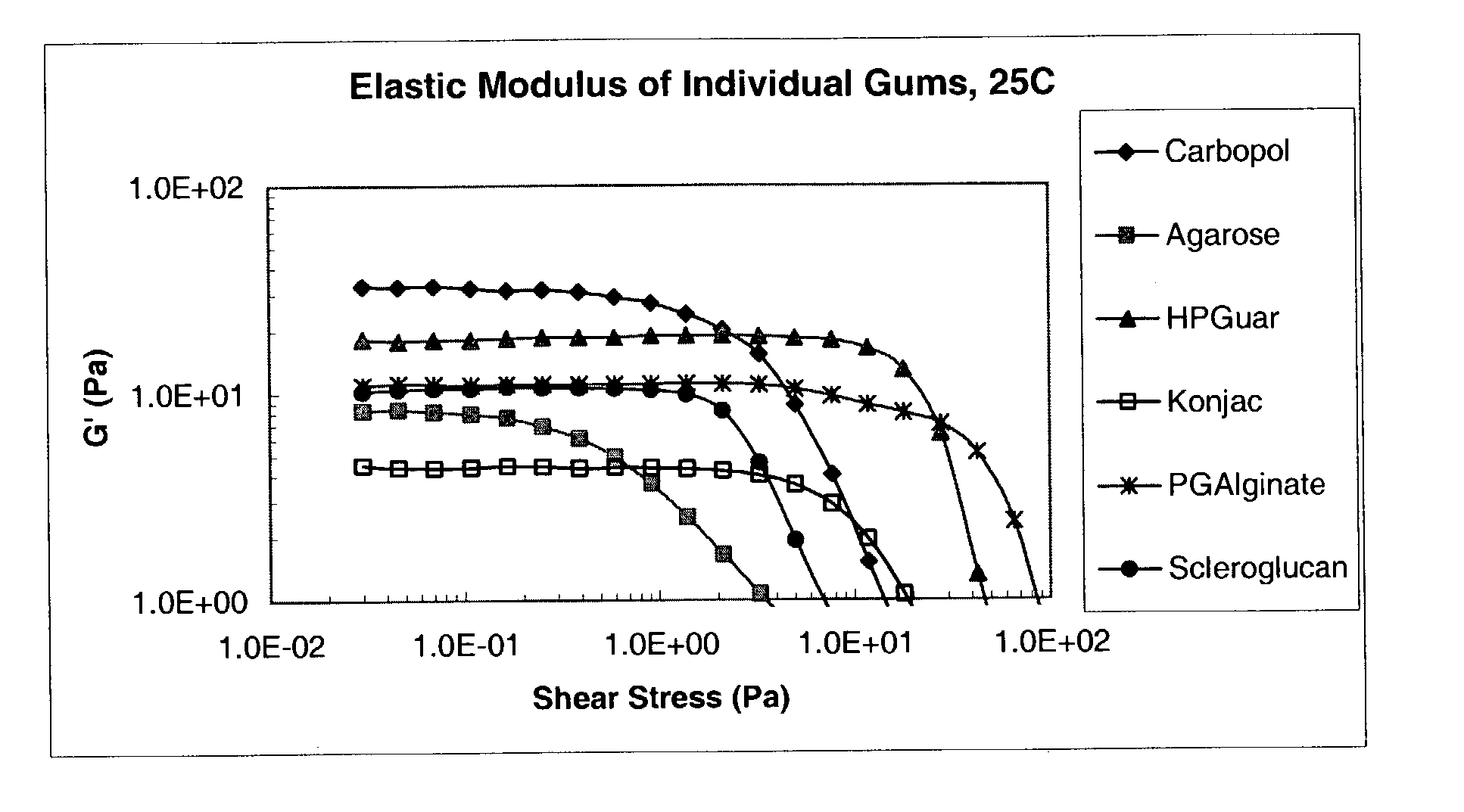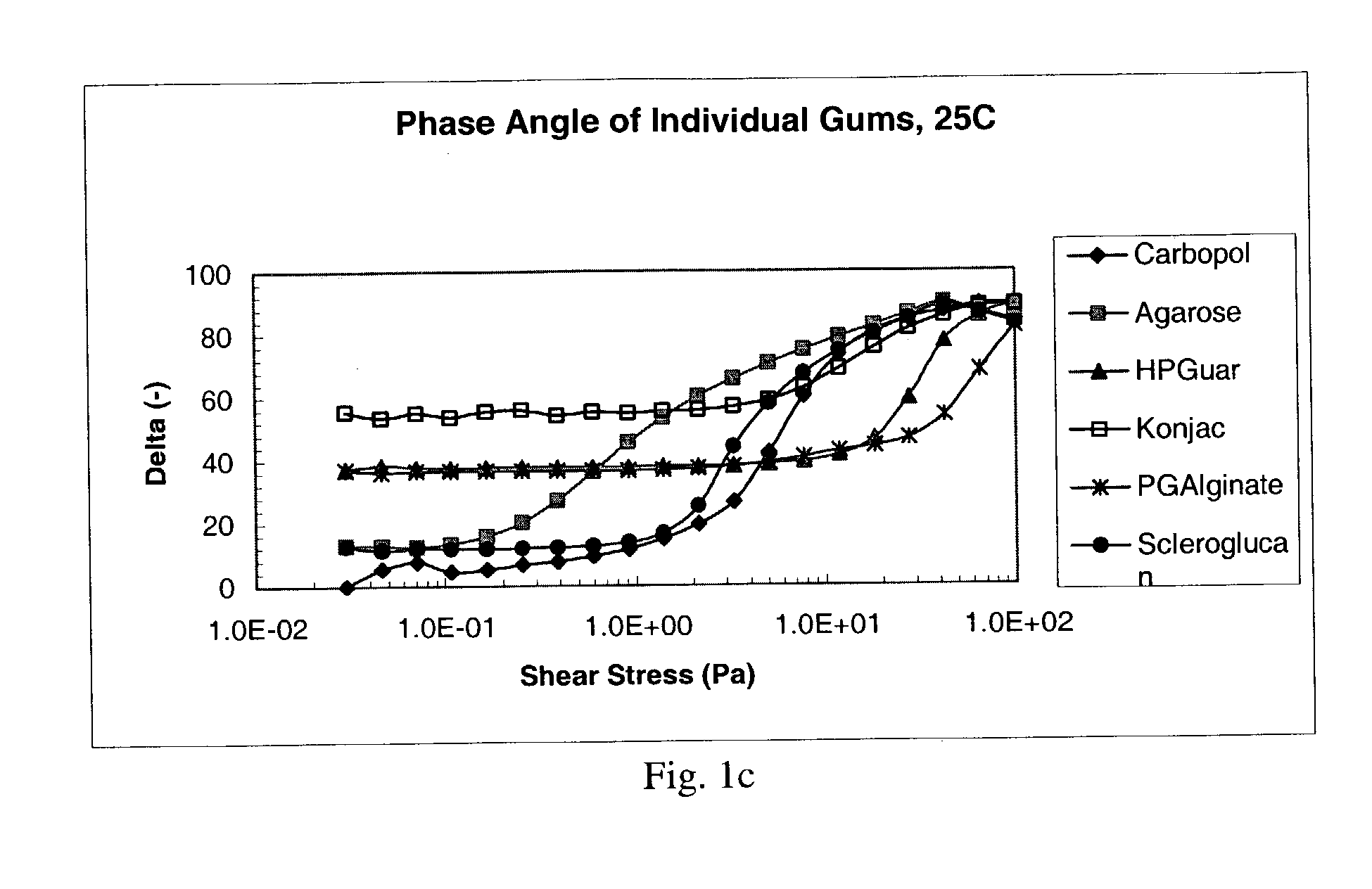Ophthalmic formulation with novel gum composition
a technology of gum and ophthalmology, applied in the field of pharmaceutical compositions, can solve the problems of high patient compliance, high cost, and rapid and extensive precorneal loss caused by drainage and high tear fluid turnover, and achieve the effects of enhancing viscosity and/or gel formation ability, low cost and high degree of patient complian
- Summary
- Abstract
- Description
- Claims
- Application Information
AI Technical Summary
Benefits of technology
Problems solved by technology
Method used
Image
Examples
example 1
Rheological Assays
[0107]The following Theological characterization assays were used to characterize the compositions prepared as described in Examples 4 to 8, below. Gum solutions were studied “As Is” at 25° C. to characterize the vehicle or formulation itself. The same solutions were also diluted in a 3:1 ratio with Artificial Tear Fluid (“ATF”), allowed to sit for 30 minutes, and then analyzed on the Rheometer at 35° C., to mimic conditions in the eye. The Artificial Tear Fluid used in this Example had the following composition: 6.8 g. NaCl, 2.25 gm NaHCO3, 1.41 gm KCl, and 0.085 g. CaCl2.2H2O. Both the As Is and the ATF samples were assayed under the following conditions.
[0108]Both of the above sets of samples were tested by taking oscillatory rheology measurements on a Bohlin CVO50 Controlled Stress Instrument using a cone and plate CP 4° / 40 mm measurement system, set to perform a stress-sweep using parameters designed to examine the range of linear viscoelastic behavior of the ...
example 2
In Vivo PK Adsorption Tests
[0120]Formulations prepared with 10 mg / mL linezolid as described in Examples below were administered to rabbit eyes to assess the concentration of Linezolid in the conjunctiva, 1 hour after application. To each 1 mL of the formulation, 0.5 mg of 14C-labeled Linezolid was added.
[0121]Four healthy male New Zealand white rabbits of body weight 1.8 to 2.5 kg were assigned to treatment with the formulation. To each of the eyes of the rabbit, 25 μL of the test formulation was applied using a pipette. Rabbits were sacrificed 1 hour after application, and eye tissues were excised. Excised tissues were combusted for liquid scintillation counting to determine radioactivity as a measure of amount of radioactivity present. Radioactive counts were converted by calculation to concentration of linezolid in μg / g.
[0122]Results of this assay are reported in Example 9, below.
example 3
In Vivo Ocular Irritation Test
[0123]Healthy male New Zealand white rabbits of body weight 1.8 to 2.5 kg were dosed with approximately 25 μL of the same test formulation used in Example 2 every two hours, and visually assessed for irritation during the dosing episode and the state of the eye monitored post-dosing.
[0124]Results of this assay are reported in Example 9, below.
PUM
| Property | Measurement | Unit |
|---|---|---|
| concentration | aaaaa | aaaaa |
| concentration | aaaaa | aaaaa |
| contact time | aaaaa | aaaaa |
Abstract
Description
Claims
Application Information
 Login to View More
Login to View More - R&D
- Intellectual Property
- Life Sciences
- Materials
- Tech Scout
- Unparalleled Data Quality
- Higher Quality Content
- 60% Fewer Hallucinations
Browse by: Latest US Patents, China's latest patents, Technical Efficacy Thesaurus, Application Domain, Technology Topic, Popular Technical Reports.
© 2025 PatSnap. All rights reserved.Legal|Privacy policy|Modern Slavery Act Transparency Statement|Sitemap|About US| Contact US: help@patsnap.com



